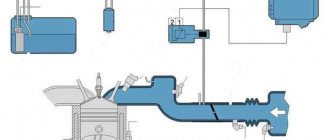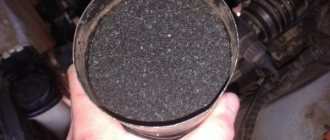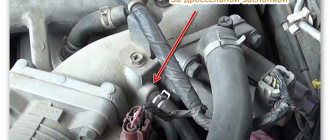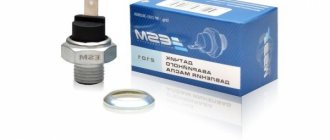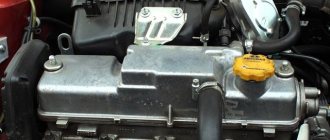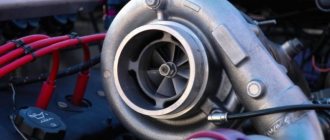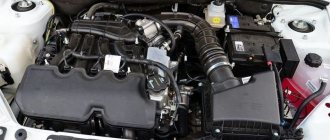Many car owners may be interested in the question of how to check the adsorber and its purge valve when the diagnostics showed it to be faulty (an absorber error popped up). It is quite possible to make such a diagnosis in a garage, however, for this it will be necessary to dismantle either the entire adsorber or only its valve. And to carry out such a test, you will need metalworking tools, a multifunctional multimeter (to measure the insulation value and the “continuity” of the wires), a pump, and a 12 V power source (or a similar battery).
What is an adsorber for?
Before moving on to the question of how to check the operation of the adsorber, let us briefly describe the operation of the gasoline vapor recovery system (in English called Evaporative Emission Control - EVAP). This will give a clearer picture of the functions of both the adsorber and its valve. So, as the name implies, the EVAP system is designed to capture gasoline vapors and prevent them from entering the surrounding air unburned. Vapors are formed in the fuel tank when gasoline is heated (most often during long-term parking under the scorching sun in the warm season) or when atmospheric pressure decreases (very rarely). The task of the fuel vapor recovery system is to return these same vapors to the engine intake manifold and burn them along with the air-fuel mixture. As a rule, such a system is installed on all modern gasoline engines in accordance with the Euro-3 environmental standard (adopted by the European Union in 1999).
The EVAP system consists of the following elements:
- carbon adsorber;
- adsorber purge solenoid valve;
- connecting pipelines.
There are also additional wiring harnesses leading from the electronic engine control unit (ECU) to the said valve. With their help, this device is controlled. As for the adsorber, it has three external connections:
- with the fuel tank (through this connection, the generated gasoline vapors directly enter the adsorber);
- with an intake manifold (it is used to purge the adsorber);
- with atmospheric air through the fuel filter or a separate valve at its inlet (provides the pressure drop necessary to purge the adsorber).
The adsorber is a kind of barrel (or similar vessel) that is filled with ground coal, in which gasoline vapors actually condense, after which they are sent to the car's power system as a result of purging. Long and proper operation of the adsorber is possible only with its regular and sufficient ventilation. Accordingly, checking the car adsorber is to check its integrity (since the body may rust) and the ability to condense gasoline vapors. Even older adsorbers pass the carbon contained in them through their system, which clogs both the system and their purge valve.
The solenoid valve for purge the adsorber directly purges the system from gasoline vapors present in it. This is done by opening it upon command from the ECU, that is, the valve is an actuator. It is located in the pipeline between the adsorber and the intake manifold.
As for checking the adsorber valve, firstly, it is checked that it is not clogged with coal dust or other debris that can get into the fuel system when it is depressurized from the outside, as well as with coal from the adsorber. And secondly, its functionality is checked, that is, the ability to open and close on a command coming from the electronic engine control unit. Moreover, not only the presence of the commands themselves is checked, but also their meaning, which is expressed in the time during which the valve must be open or closed.
Interestingly, in engines equipped with a turbocharger, a vacuum is not created in the intake manifold. Therefore, for the system to operate, it is provided with another two-way valve that operates and directs fuel vapor into the intake manifold (if there is no boost pressure) or to the compressor inlet (if there is boost pressure).
Please note that the canister solenoid valve is controlled by an electronic unit based on a large amount of information from temperature sensors, mass air flow, crankshaft position and others. In fact, the algorithms by which the corresponding programs are built are quite complex. It is important to know that the greater the engine air consumption, the longer the duration of the control pulses from the ECU to the valve and the stronger the canister purge.
That is, what is important is not the voltage supplied to the valve (it is standard and equal to the total voltage in the automotive electrical network), but its duration. There is such a thing as “adsorber purge duty cycle”. It is scalar and is measured from 0% to 100%. A zero threshold indicates that there is no purging at all, respectively, 100% means that the adsorber is purged as much as possible at a given time. However, in reality this value is always somewhere in the middle and depends on the operating conditions of the machine.
Also, the concept of duty cycle is interesting because it can be measured using special diagnostic programs on a computer. An example of such software is the Chevrolet Explorer or OpenDiag Mobile programs. The latter is perfect for checking the adsorber of domestic cars VAZ Priora, Kalina and other similar models. Please note that an additional scanner, such as an ELM 327, is required to use the mobile application.
Replacing the adsorber purge valve (KPA) on a Lada Granta on your own
Today's article will be devoted to the fuel vapor recovery system, or more precisely, to the adsorber purge valve. You will learn what an adsorber purge valve is, what it is intended for, how to understand that the purge valve has failed, and also how to replace the control unit on a Lada Granta.
A little theory...
What is a canister purge valve?
In fact, the topic is quite extensive and it would take a very long time to describe the operating principle of the control unit, as well as all the intricacies of the fuel vapor ventilation system. But since the main idea of my article today is to replace the adsorber purge valve with your own hands, I will only touch on the theory superficially.
In general, as environmental standards and requirements of international associations for automakers became more stringent, cars began to be “overgrown” with various sensors, controllers and entire systems, the main task of which was to reduce the level of harmful emissions into the atmosphere. And if the catalyst burns already exhaust gases and neutralizes the level of harmful CO/CO2/CH/NO, then the adsorber fights fuel vapors.
The adsorber, which I already talked about once, is a small box or reservoir filled with fine coal, which absorbs fuel vapor, thereby performing two functions - ventilation and neutralization of harmful fumes. The work of the adsorber is extremely important when the engine is stopped; it is after you have turned off the engine that the adsorber begins to absorb and neutralize all fumes coming from the fuel tank.
When you start the engine, the adsorber purge valve turns on. It provides ventilation for fuel vapors, which are removed from the adsorber and enter the intake manifold, where they are burned during engine operation. In this way, the adsorber is “purged”, ventilated, and harmful fumes are neutralized by burning them
Read more about what an adsorber is, the principle of its operation, as well as the main malfunctions in this article, if you are interested, you can be curious, and we will move on to a more important topic
Error P0441 appears - “Incorrect air flow through the adsorber purge valve”; Fuel consumption increases; Dynamics worsen; Unstable engine operation at idle.
How to check the Lada canister purge valve?
- We remove the PDA and supply 12 V power to the terminals. The working valve should click; if the valve does not make any sounds or clicks, it is most likely out of order or, in other words, jammed.
- Second way to check. We take the CPA and try to blow it out with our mouth; if it blows through without problems, then the valve is not working. A working purge valve cannot be purged without power.
Replacing the canister purge valve on a Lada Granta with your own hands
In the store we buy a new control unit, as well as two small clamps and a hose of a suitable diameter, usually a fuel hose is suitable. We take a minimum set of tools (screwdriver, knife, pliers) and get to work, the whole process will take you no more than half an hour.
- The first thing to do is to remove the air corrugation from the air vent body; to do this, take a screwdriver and loosen the clamps. We remove the pipe and under all this equipment we find our valve.
- We disconnect the KPA mount and turn off its power; it has a block with a latch that you need to press on. Then disconnect the canister valve pipes one by one.
- One hose is the one made of “oak” plastic, put on a fitting, you can simply cut it off, don’t try to remove it, even if everything works out, it won’t stick tightly to the new valve. Moreover, we have everything provided and a new pipe has been prepared. If you really want to, you can use sealant and try to seal the connection of the old hose with it.
We remove all quick-release connections and twist them onto a new hose.
It is important not to mix up the hoses and connectors themselves, so as not to disrupt the operation of the ventilation system
We assemble everything in the reverse order and fasten the air duct pipe in place. Next, start the engine and make sure that the problem has disappeared. It is better to erase the error first.
I’ll end here, as you can see, there’s nothing complicated. Replacing the canister purge valve is not much more difficult than replacing the air filter. Try it and you will definitely succeed. If the article was useful to you, share the link to it with your loved ones by copying the link for social networks or using the special buttons below. I would also be grateful if you leave a meaningful comment. Goodbye everyone and see you again at VAZ Repair.
Photo from here: https://www.drive2.ru/l/8677844/, https://www.drive2.ru/l/7641808/
External signs of malfunction
Before checking the adsorber purge valve, as well as the adsorber itself, it will certainly be useful to find out what external signs accompany this fact. There are a number of indirect signs, which, however, can be caused by other reasons. However, when identifying them, it makes sense to also check the operation of the EVAP system, as well as its constituent elements.
- Unstable engine operation at idle speed (the speed “floats” to the point where the car starts and stalls, because it runs on a lean air-fuel mixture).
- A slight increase in fuel consumption, especially when the engine is running “hot”, that is, in a warm state and/or in hot summer weather.
- It is difficult to start a car engine when it is hot; it is usually impossible to start it the first time. And at the same time, the starter and other elements associated with starting are in working condition.
- When the engine operates at low speeds, the loss of power is very noticeable. And at higher speeds there is also a decrease in torque.
In some cases, it is noted that if the normal operation of the gasoline vapor recovery system is disrupted, the smell of fuel may enter the cabin. This is especially true when the front windows are open and/or when the car is parked for a long time in a closed box or garage with poor ventilation. Also, poor operation of the system is caused by depressurization of the fuel system, the appearance of small cracks in fuel lines, plugs, and so on.
How to check the adsorber
Now let’s move directly to the algorithm for checking the adsorber (its other name is the fuel vapor accumulator). The main task in this case is to determine how sealed its body is and whether it allows fuel vapors to escape into the atmosphere. So, the check must be performed according to the following algorithm:
- Disconnect the negative terminal from the vehicle battery.
- First, disconnect all hoses and contacts going to it from the adsorber, and then remove the fuel vapor accumulator directly. This procedure will look different for different machines, depending on the location of the assembly, as well as the mounting means with which it was secured.
- It is necessary to plug (seal) the two fittings tightly. The first one goes directly to atmospheric air, the second one goes to the solenoid purge valve.
- After this, use a compressor or pump to apply a slight air pressure to the fitting going to the fuel tank. Don't overdo it with pressure! A working adsorber should not leak from the housing, that is, be sealed. If such leaks are detected, then most likely the unit needs to be replaced, since it is not always possible to repair it. In particular, this is especially true if the adsorber is made of plastic.
How to replace?
Replacing this part yourself is not difficult. If there are signs of a malfunctioning adsorber, do not hesitate - replace it. It will only take a few tens of minutes. So, we buy the necessary spare part (and it is inexpensive). We will need several clamps, bolts, and tools. Yes, and don’t forget to replace the hose, as it may also be “broken.”
Read more: When I open the car, the autostart stalls
According to the requirements of new environmental standards that limit the content of harmful substances in exhaust gases, vehicles must be equipped with an EVAP system. This equipment prevents harmful fuel fumes from entering the atmosphere. The main function in the fuel vapor recovery system is performed by the adsorber. Some people underestimate the importance of this element in the operation of a car. However, a malfunction of this seemingly minor component can lead to damage to the fuel pump and affect the operation of the entire engine. Therefore, experts recommend checking the adsorber valve when signs of engine malfunction appear.
How to check the adsorber valve
If after checking it turns out that the adsorber is in more or less working condition, then it makes sense to check its purge solenoid valve. It’s worth mentioning right away that for some machines, due to their design, some actions will differ, some of them will be present or absent, but in general the verification logic will always remain the same. So, to check the adsorber valve, you must perform the following steps:
- Visually check the integrity of the rubber hoses included in the fuel vapor recovery system, in particular those directly approaching the valve. They must be intact and ensure the tightness of the system.
- Disconnect the negative terminal from the battery. This is done to prevent false alarms of the system diagnostics and to enter information about the corresponding errors into the electronic control unit.
- Remove the absorber (usually it is located on the right side of the engine, in the area where the air system elements are installed, in particular the air filter).
- Turn off the electrical power to the valve itself. This is done by removing the electrical connector (the so-called “chip”) from it.
- Disconnect the inlet and outlet air hoses from the valve.
- Using a pump or medical bulb, you must try to blow air into the system through the valve (into the holes for the hoses). It is important to ensure the tightness of the air supply. To do this, you can use clamps or a thick rubber tube.
- If everything is in order with the valve, it will be closed and air will not be blown through. Otherwise, its mechanical part will fail. You can try to restore it, but this is not always possible.
- It is necessary to supply electric current from the power supply or battery using wires to the valve contacts. At the moment the circuit closes, you should hear a characteristic click, which signals that the valve has actuated and opened. If this does not happen, then perhaps instead of a mechanical failure there is an electrical failure, in particular, its electromagnetic coil has burned out.
- With the valve connected to an electric current source, you must try to blow air into it in the manner described above. If it is working properly, and therefore open, then this should work without problems. If it is not possible to pump through air, then the valve has failed.
- Next, you need to reset the power from the valve, and there will be a click again, indicating that the valve has closed. If this happens, it means the valve is working.
You can also check the adsorber valve using a multifunctional multimeter, switched to ohmmeter mode - a device for measuring the insulation resistance value of the electromagnetic winding of the valve. The probes of the device must be placed at the coil terminals (the places where the wires coming from the electronic control unit are connected to it; there are various design solutions), and the insulation resistance between them must be checked. For a normal, serviceable valve, this value should be within approximately 10...30 Ohms or differ slightly from this range. If the resistance value is small, it means that there is a breakdown of the electromagnetic coil (short interturn circuit). If the resistance value is very large (calculated in kilo- and even mega-ohms), then the electromagnetic coil breaks. In both cases, the coil, and therefore the valve, will be unsuitable for use. If it is sealed into the housing, then the only way out of the situation will be to completely replace the valve with a new one.
Thus, in order to know how to check whether the adsorber valve is working properly, you need to dismantle it and check it in a garage. The main thing is to know where its electrical contacts are located, and also to perform a mechanical inspection of the device.
Canister purge valve
Adsorber valve: how it works and works, main malfunctions
I decided to call this article exactly that, although the adsorber valve itself is not the main character here. It all started when my engine fault light came on (the check engine light came on). I waited for the next maintenance (fortunately it happened shortly before the scheduled maintenance) and informed the car service employees about it. They carried out diagnostics and said that the culprit was the canister purge valve, but they did not have this valve in stock, and for now it was possible to drive as is. I must say that at that time there were two weeks left before the end of the warranty, but they swore that they would replace the valve free of charge, even if the warranty had already expired by the time the valve arrived at the warehouse.
I was happy (despite everything, I never stop believing people)))), and in the article Three years on Priora I hastened to write that the adsorber valve was replaced under warranty. However, I was in a hurry...
As you may have guessed, no one was going to change anything for me for free. After several dozen phone calls to the car service center, I came to the disappointing conclusion that I had been duped once again. There was neither time nor desire to go to court over such a trifle. And I decided to change the canister purge valve on the Priora myself. But the experience of dealing with car services still taught me something, and I decided to check whether this ill-fated valve was really the problem.
The Priora's standard computer showed error 4. This is an error in the coolant temperature sensor. Of course, this could have been an accidental mistake. I didn't have the opportunity to use another computer or connect a laptop, so I tried to determine the source of the problem based on the symptoms. And the symptoms were:
- Sometimes (rarely) the engine was not very stable at idle
- Fuel consumption has increased quite slightly (almost imperceptibly - pure intuition)
- Sometimes a hot engine would not start the first time
- The engine began to pull worse (especially at low speeds), but also not much worse
After surfing the Internet, I came to the conclusion that the malfunction was somehow related to the air. And I read in several sources that the cause of this problem may be worn out rubber bands on the exhaust manifold fittings (see Fig. 1).
Rice. 1. Canister purge valve.
For various reasons, these rubber plugs deteriorate and lose their seal. Through the formed holes (Fig. 2), air begins to be sucked in, which leads to minor disturbances in engine operation.
Rice. 2. Damaged plug.
They write on the Internet that instead of these rubber bands you can use rubber bands from the brake cylinder bleeding fittings. You can probably install other suitable rubber bands. However, I only had tape on hand. I carefully wrapped the damaged elastic band with this tape (Fig. 3).
Rice. 3. Repair the plug using tape.
And, lo and behold, the engine malfunction light went out (of course, after resetting the errors). Of course, tape is a temporary solution to the problem. Most likely, it will not withstand temperature changes, especially in winter. But I’ve already been away for several weeks and so far everything is fine.
Conclusion
: no matter how developed the diagnostic tools are, people who work with them do not always have sufficient qualifications. And it may well be that in your case, instead of purchasing a new adsorber valve for 1500...2000 rubles (or so), you will solve the problem with the help of adhesive tape and such and such)))))
Well, if you still suspect the adsorber valve, then you can check its operation using improvised means.
We disconnect the negative terminal of the battery and remove the canister purge valve, which is held on the plastic engine cover with a latch (Fig. 1). Disconnect the power supply to the valve and the air supply/exhaust hoses. Then we try to blow the valve through the holes for the hoses. A serviceable valve is closed when the power is turned off, that is, it should not be purged.
Then carefully connect two wires to the valve power connectors and connect them to the battery (polarity does not matter). The valve should click quietly, that is, open. We try to blow out the valve again, now air should pass through the valve freely, that is, when power is applied, the valve opens. Turn off the power - the valve should close again and stop blowing.
If you succeeded in all this, then the valve itself is 99.99% likely to be working. However, there remains the possibility of malfunction of the valve control circuits. But that is another story…
How to repair the adsorber and valve
It’s worth noting right away that in most cases both the adsorber and the valve cannot be repaired; accordingly, they need to be replaced with similar new units. However, as for the adsorber, in some cases, over time, the foam in its body rots, which is why the carbon contained in it clogs the pipelines and the solenoid valve of the EVAP system. Rotting of foam rubber occurs for banal reasons - from old age, constant temperature changes, exposure to moisture. You can try to replace the foam separator of the adsorber. However, this cannot be done with all units; some of them are non-separable.
If the adsorber body is rusted or rotten (usually also due to old age, temperature changes, constant exposure to moisture), then you can try to restore it, but it is better not to tempt fate and replace it with a new one.
Similar reasoning is valid for the solenoid valve of the gasoline vapor recovery system. Most of these units are non-separable. That is, the electromagnetic coil is sealed into its body, and if it fails (insulation breakdown or winding break), it will not be possible to replace it with a new one. Same with the return spring. If it has weakened over time, you can try to replace it with a new one, but this is not always possible. But despite this, it is still better to perform a detailed diagnosis of the adsorber and its valve in order to avoid expensive purchases and repairs.
Some car owners do not want to pay attention to the repair and restoration of the gasoline vapor recovery system, and simply “turn off” it. However, this approach is not rational. Firstly, this really affects the environment, and this is especially noticeable in large cities, which are not known for their clean environment anyway. Secondly, if the EVAP system does not work correctly or does not function at all, then under pressure gasoline vapors will periodically escape from under the gas tank cap. And this will happen as often as the temperature in the gas tank increases. This situation is dangerous for several reasons.
Purpose
This spare part was not always part of the car. We owe its appearance to modern requirements for the environmental performance of cars, and to be more precise, the Lada Granta acquired an adsorber thanks to Euro-3.
(Euro-3 is an environmental standard that was introduced in 1999, but Russian manufacturers were able to meet its requirements only in 2008.)
The adsorber, for which Granta became one of the first “shelters” in the domestic automotive market, is a spare part directly connected to the catalyst. It allows you to accumulate gasoline vapors to prevent them from entering the exhaust manifold.
Such actions allow you to preserve the catalyst and prevent its premature wear, since the combination of a cold catalyst with gasoline vapor is unacceptable. As soon as the engine warms up to the required temperature, the adsorber purge sensor is activated. The adsorber valve drives the vapors back into the gas tank.
Additional features
Of course, initially, created to create environmentally friendly engine operation, the Lada Granta adsorber, the price of which is insignificant, was underestimated. Manufacturers tried with all sorts of tricks to circumvent this newfangled trend, but the law obliged all car manufacturers who did not comply with this innovation to pay heavy fines.
Although AvtoVAZ has never been known for its large exports, it was forced to take measures to install an adsorber, since it has a small, but still a sales market. Today, the adsorber is installed on the Lada Granta without fail, since world research has revealed the following capabilities of this component:
– reduction in gasoline consumption
A similar result is achieved because the adsorber valve allows gases to be driven back into the gas tank, from where they enter the engine, which, when warm, is capable of processing them. If this device is missing, or the canister valve itself does not work, Granta loses fuel, which significantly increases consumption.
– normalization of exhaust system operation
Thanks to filtration, the likelihood of premature wear of the system and its components disappears.
Valve - as the most important component of the device
Speaking about how the adsorber valve works, it is necessary to introduce the device itself. It is, roughly speaking, a can of coal, which is equipped with a valve that allows the vapor to condense and direct. The canister purge valve is controlled by the ECU, which sends a signal to open/close it.
Important. The adsorber solenoid valve can create certain troubles for the driver. In the cold season, when starting a cold engine, a certain sound similar to clicking may be heard. This sound is normal, since the valve may not work correctly when cold.
In order not to confuse this sound with possible breakdowns, it is necessary to apply gas control. If there are no changes, you can safely attribute the clicks to the absorber.
Features of valve operation
The Grant canister purge valve itself was inherited from Kalina. Thus, the Kalina adsorber purge valve and the Lada Granta adsorber purge valve are completely identical. This allows us to assert that the signs of adsorber malfunction in both cars are identical.
If we take into account the Kalina adsorber purge solenoid valve, malfunctions and their symptoms can be completely attributed to a malfunction of the adsorber of its younger brother.
Principle of operation
The adsorber itself allows fuel vapors to accumulate in a special place - the separator. As a result, gasoline turns into condensate and goes back to the tank. Vapors that have not undergone treatment go through double valves of the system, one of which prevents fuel from spilling out during an emergency (for example, a coup), and the second “is engaged” in regulating the pressure in the tank. The adsorber purge valve is located under the hood, and the adsorber itself is located on the tank. The control unit ensures the normal operation of the entire system: it ventilates and removes condensation.
Article on the topic: The airbag is on on the instrument panel: reasons for the indicator to fire, diagnostics, solution to the problem
How to understand a malfunction of the absorber
Speaking about the adsorber valve, the symptoms of a malfunction will be fairly standardized, which makes it possible to obtain a fairly detailed description. So, signs of a malfunctioning adsorber valve:
– Constant smell of gasoline in the cabin.
This fact is caused by improper circulation of gases, which may have a certain leakage. Due to the proximity of the system to the air filter, odors freely penetrate into the cabin.
Signs of a malfunction of the canister purge valve on the Grant include this sound, familiar to all Grant owners.
(to fix this, you can tighten the nut, or you can purchase a new one; fortunately, the Lada Granta adsorber valve, the price of which is low, is available for purchase)
– Increased fuel consumption.
An inoperative adsorber ventilation valve is not able to control the correct path of gases, which does not allow them to be processed in the form of combustion.
– The amount of harmful substances released through the system increases.
Speaking about how the canister purge valve works and why, do not forget that increasing the environmental performance of a car is a primary task, which can be disrupted if the canister purge solenoid valve does not function correctly.
- Sounds similar to some hissing.
Strong hissing in the adsorber hose, the cause of which is the accumulation of gases, is not uncommon. Since modern requirements for cars do not allow gas emissions while parked, a certain accumulation is acceptable.
– Characteristic sounds coming from the gas tank.
Speaking about the Lada Granta adsorber, the malfunction of which is always characterized by extraneous sounds coming from the gas tank, it must be said that they are the most typical sign of a breakdown. In this case, the adsorber sensor may not give any indicators of malfunction, therefore, it must also be replaced.
Thus, signs of a malfunction of the Lada Grant canister purge valve are quite easy to identify. In addition, they are detected when simply refueling the car, which necessarily requires opening the gas tank cap.
Malfunctions of the adsorber valve and their elimination
Almost continuous operation of the fuel vapor absorption system canister can cause damage to the purge valve. A malfunction of the canister valve often leads to damage to the fuel pump. Due to poor ventilation of the adsorber, gasoline accumulates in the intake manifold, the engine loses power, and fuel consumption gradually increases. This may cause the engine to stop completely. The operation of the entire vehicle depends on how the adsorber valve works.
How to check the functionality of the canister purge valve?
Checking the absorber valve
In order to notice and correct problems in time, regular checks of the adsorber valve are necessary. In this case, a breakdown can be identified by certain indirect signs. When the engine is idling or in cold weather, the vapor absorption system makes characteristic sounds, like the canister valve clicking. Some people confuse this sound with a faulty timing belt, rollers or other parts. You can check this by sharply pressing the gas pedal. If the sound has not changed, it means the canister valve is clicking. Experts can explain what to do if the canister valve knocks too loudly. To do this, you need to tighten the adjusting screw, and first it is cleared of epoxy resin.
The screw turns approximately half a turn. If you tighten it too much, the controller will generate an error. This adjustment of the adsorber valve will make its operation softer and the knocking noise quieter. However, how to check the adsorber valve for damage? Valve failure can be determined using an error diagnostic system or mechanical testing. Electronic error codes are stored in the controller's memory and indicate electrical damage
To check the valve, it is recommended to pay attention to errors generated by the controller, such as “open circuit of the canister purge valve control circuit.” Signs by which a malfunction of the adsorber valve can be mechanically determined:
- The appearance of dips at idle speed of the engine.
- Very low engine thrust.
- There is no sound of valve operation when the engine is running.
- A hissing sound when the gas tank cap is opened indicates a vacuum in the system. This is a sure sign of a malfunction in the adsorber ventilation.
- The appearance of a fuel smell in the car interior. However, its appearance can also be caused by other reasons.
Read more: Do-it-yourself tire tucking
How to repair a problem
When talking about repairing the adsorber, the fault should be clearly identified. For example, if we are talking about the Grant adsorber purge valve, the malfunction of which can be indexed by the lack of high-quality gas removal, a new VAZ adsorber purge valve can be a solution to the problem.
The repair of the adsorber valve itself comes down to using a Phillips screwdriver and its application. The procedure for influencing the Lada Granta adsorber sensor:
1) We remove the terminals so that there are no disastrous consequences.
2) Apply physical force and gently remove the valve.
3) We compare the new valve and the old one, because anything can happen in life. Buying an adsorber valve, of course, is a simple thing, but there are mistakes made by sellers/storekeepers who may mistakenly sell an unnecessary spare part.
4) We insert a new valve, assemble this system, return the terminals to their place and enjoy life. The Grant adsorber purge valve, the price of which is almost equally low throughout the Grant sales area, is also a reason for a small, but still joy.
It is impossible in the course of the story about the adsorber not to mention the fact that a huge number of Lada Grant owners prefer to remove this device. There are two reasons for this action:
– lack of desire to repair
– lack of faith in the possible environmental benefits of installing this device in your car
Do-it-yourself absorber valve replacement
If signs of malfunction are detected, the valve will need to be repaired or replaced. The adsorber valve is inexpensive and easy to replace. To dismantle you need to have a pair of Phillips screwdrivers and know where the canister purge valve is located. Operating procedure:
The markings on the old and new valves must match.
- Open the hood and find a cylindrical device - an adsorber.
- Remove the negative terminal from the battery.
- Disconnect the wire block by pressing the latch and pulling it towards you.
- Loosen the valve.
- Remove the fittings under the latch and disconnect the hoses.
- Remove the valve together with the bracket from the adsorber.
- The new valve is installed in the reverse order.
Thus, even such a small element as the adsorber valve performs important functions and its malfunction can seriously disrupt the operation of the entire engine. Therefore, it is important to monitor the condition of your car and carry out diagnostics on time.
An electromagnetic valve, called an adsorber, is present on every engine with injection type injection. However, few people realize why this detail is needed. The adsorber is designed to accumulate fuel vapors that are heated in the fuel tank. Thus, when the engine starts, it is the vapors accumulated by the adsorber that enter the manifold and combustion chamber, for which a special purge valve is responsible, which regulates the condensate and ventilates the system.
Price policy
Speaking about the Grant adsorber purge valve, which can be purchased today in all large and not so large places for selling spare parts for the Russian auto industry, it is impossible not to note its pleasant price. The Grant adsorber valve, the price of which is equivalent to the probability of its failure, allows for independent replacement and is a simple mechanism.
Thus, maintaining the environmental standards of the Lada Granta is truly a man-made matter. The adsorber has become a part that, in addition to caring for the environment, can significantly reduce fuel consumption and improve the operation of exhaust gas removal.
